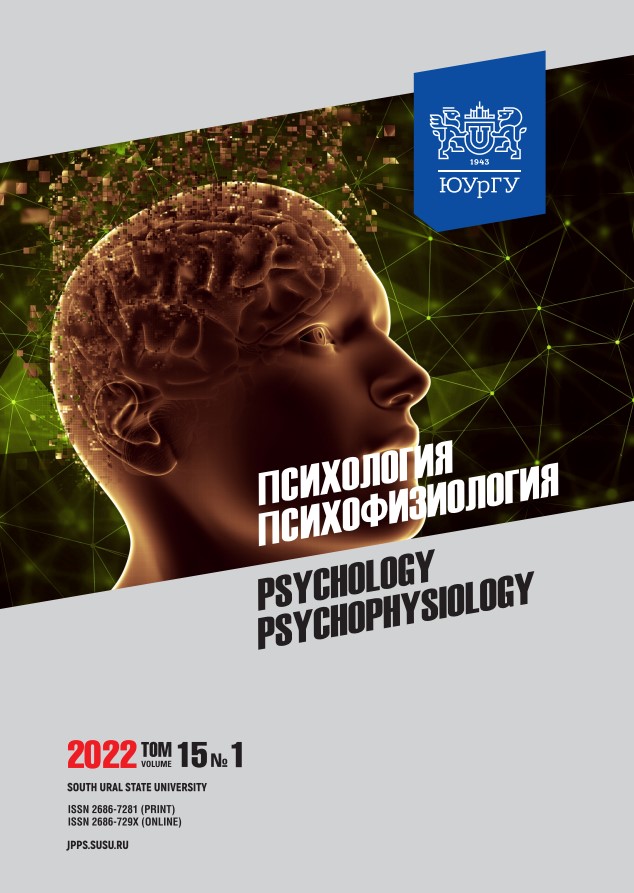Algorithm for verifying the results of the color-stimulus test
Abstract
Introduction. The paper deals with the problem of poor results verification in online psychological tools. The assumptions accepted by default as true when creating test methods are listed with related informational value and bias. The algorithm was proposed for identifying the abnormal behavior of subjects during test procedures. Aim. The paper aims to describe the capabilities and limitations of the device that allowed to identify intentionally false responses to test items. Materials and methods. The study involved 50 graduates (mean age 26 ± 2 years) of secondary specialized or higher educational institutions and novice employees (experience of up to one year). The following psycho(physio)logical tools were used for the purpose of the study: the “Videotsvetomer” software (Tsvetomer system), which corresponds to the same name method of measuring color-stimulus reaction; the GazePoint HD3 biometric video assessment system. Throughout the color test session, video monitoring of subjects’ eye movements was performed. Results. The algorithm was proposed for verifying the results of the color-stimulus test by using the “Videotsvetomer” software, which combines the use of color stimulus associations and video oculography. The results are as follows: sincere responses are accompanied by a clear differentiation of the eye movement areas associated with different groups of labels. Intentionally false responses require longer time to look at the labels, while eye movement areas are indistinct. Moreover, in the case of sincere responses, the majority of time was spent looking at the stimulus, while intentionally false answers required the subject to spend more time ‘‘scanning’’ the labels. Therefore, the eye-gaze-tracking technology makes it possible to identify labels with their positive or negative stimulus. Conclusion. The paper provides the potential for using the proposed method in psychometrics.
Downloads
References
2. Ivanov O.S., Pilkevich S.V., Gnidko K.O. et al. Justification for the Terminological Basis Studies of the Human Psyche Contaminations Forms. Vestnik Rossiiskogo novogo universiteta. Seriya: Slozhnye sistemy: modeli, analiz i upravlenie = Vestnik of Russian New University. Series: Complex systems: models, analysis, management. 2019;3:69–76. DOI: https://doi.org/10.25586/ RNU.V9187.19.03.P.069 (in Russ.).
3. Mazilov V.A. Psychology History: the Fact Problem. Yaroslavskii pedagogicheskii vestnik = Yaroslavl Pedagogical Bulletin. 2017;3:151–158. (in Russ.).
4. Assanovich M.A. Invariance of psychometric models. Zhurnal Grodnenskogo gosudarstvennogo meditsinskogo universiteta = Journal of the Grodno State Medical University. 2014;2(46):47–49. (in Russ.).
5. Vasserman L.I., Iovlev B.V., Chervinskaya K.R. Computer psychodiagnosis in the theory and practice of medical psychology: the stage and the aspects for development. Sibirskii psikho-logicheskii zhurnal = Siberian Journal of Psychology. 2010;35:20–24. (in Russ.).
6. Alekhin A. Psychological Phenomenon as a Methodological Problem Izvestiya Rossiiskogo gosudarstvennogo pedagogicheskogo universiteta imeni A.I. Gertsena = Scientific journal of Herzen University. 2013;155:16–23. (in Russ.).
7. Posokhova S.T. Modern psychological diagnosis: theoretical and ethical aspects. Vestnik Sankt-Peterburgskogo universiteta. Sotsiologiya = Vestnik of Saint-Petersburg University. Sociology. 2010;3:7–17. (in Russ.).
8. Pilkevich S.V., Gnidko K.O., Sabirov T.R. et al. Programmnyi modul parametrizatsii logiko-lingvisticheskogo opisaniya klassov destruktivnogo mediakontenta na osnove okulograficheskikh dannykh [Software module for parameterization of logical-linguistic description of classes of destructive media content based on oculographic data]. Certificate of registration of a computer program RF, no. 2020666435, 2020. (in Russ.).
9. Boyko V.A. Intelligent testing system architecture. International Journal of Applied Sciences and Technologies “Integral” = INTEGRAL. International journal of applied sciences and technology. 2021;2-1:347–352. (in Russ.).
10. Merkulova E.A., Kozulin I.A., Savostyanov A.N., Bocharov A.V., Knyazev G.G. Repeatability of the Data from Social Interactions Experiments Depending on Personal Characteristics. Vestnik novosibirskogo gosudarstvennogo universiteta. Seriya: Informatsionnye tekhnologii = Vestnik NSU. Series: Information Technologies. 2020;18(3):34–43. (in Russ.). DOI: https://doi.org/ 10.25205/1818-7900-2020-18-3-34-43
11. Sugonyaev K.V. Atypical Responses Scales as the Tool of Non-Cooperative Testing Behavior Detection. Vestnik Yuzhno-Uralskogo gosudarstvennogo universiteta. Seriya “Psikhologiya” = Bulletin of the South Ural State University. Ser. Psychology. 2016;9(1):17–26. (in Russ.). DOI: https://doi.org/10.14529/psy160102
12. Medikov E.V., Demidova T.E. Social dependency and social parasitism in modern Russia: causes and factors influencing their appearance. Sotsiologiya = Sociology .2020;6:88–93. (in Russ.).
13. Ivanov O.S., Kapitanaki V. E., Chermianin S.V., Pilkevich S.V. Verification of the results of psychosemantic survey by eyes–gaze–tracking. CEUR Workshop Proceedings. 2021;2556:15–20. Available at: http://ceur–ws.org/Vol–2556/paper3.pdf (accessed 14.12.2021)
14. Ivanov O.S., Titov S.V., Titov S.S. “Vebtsvetomer”. Certificate of registration of a computer program RF, no. RU2020667243, 2020. (in Russ.).
15. Seha S.N.A., Hatzinakos D., Zandi A.S., Comeau F.J.E. Improving eye movement biometrics in low frame rate eye-tracking devices using periocular and eye blinking features. Image and Vision Computing, 2021;108:104124. DOI: https://doi.org/10.1016/j.imavis.2021.104124.
16. Ivanov O.S., Chermyanin S.V., Kapitanaki V.E., Pilkevitch S.V., Sabirov T.R. Approach to verifcation of psychometric test results by integrating the methods of tempometry and video-oculography. Neuropsychological Trends. 2021. DOI: http://dx.doi.org/10.7358/neur-2021-30-ivan.
17. Maksimikhina E.V., Shkuropatov D.A. Features of dynamics of simple and complex sensomotor reaction in trainers and athletes a t the initial stage of preparation. Izvestiya Tulskogo gosudarstvennogo universiteta. Fizicheskaya kultura. Sport = Bulletin of TulSU. Physical culture. Sport. 2020;10:142–148. (in Russ.). DOI: http://dx.doi.org/10.24411/2305-8404-2020-11019
18. Ivanov O.S., Pilkevich S.V., Gnidko K.O., Lokhvitskii V.A., Dudkin A.S., Sabirov T.R. Ontological design of a software tool for evaluating the impact of Internet content on the users psychological health. Mir nauki. Pedagogika i psikhologiya = World of Science. Pedagogy and psychology. 2020;5(8). Available at: https://mir-nauki.com/PDF/56PSMN520.pdf (accessed 14.12.2021) (in Russ.).
References on translit
-Copyright (c) 2022 Psychology. Psychophysiology

This work is licensed under a Creative Commons Attribution-NonCommercial-NoDerivatives 4.0 International License.



